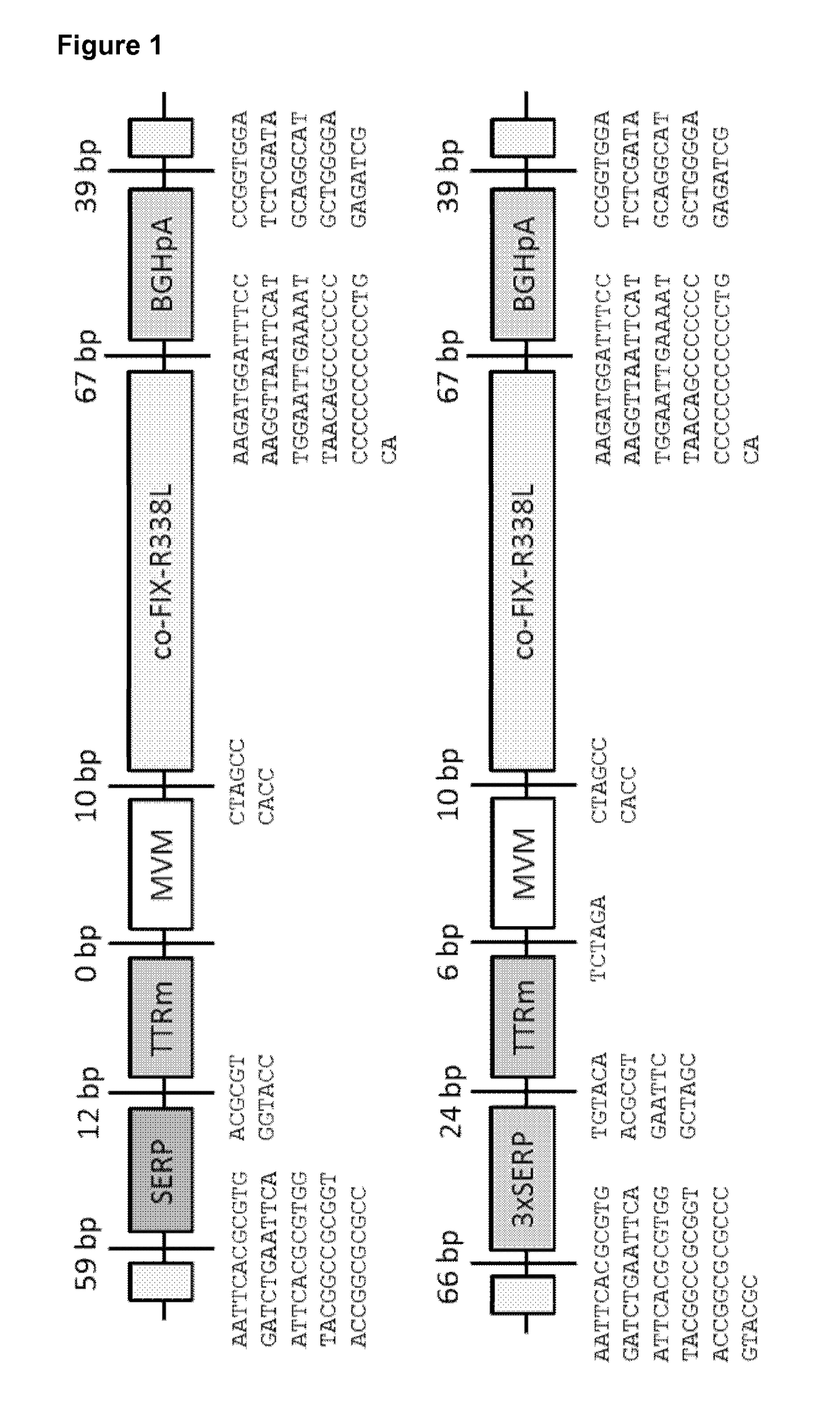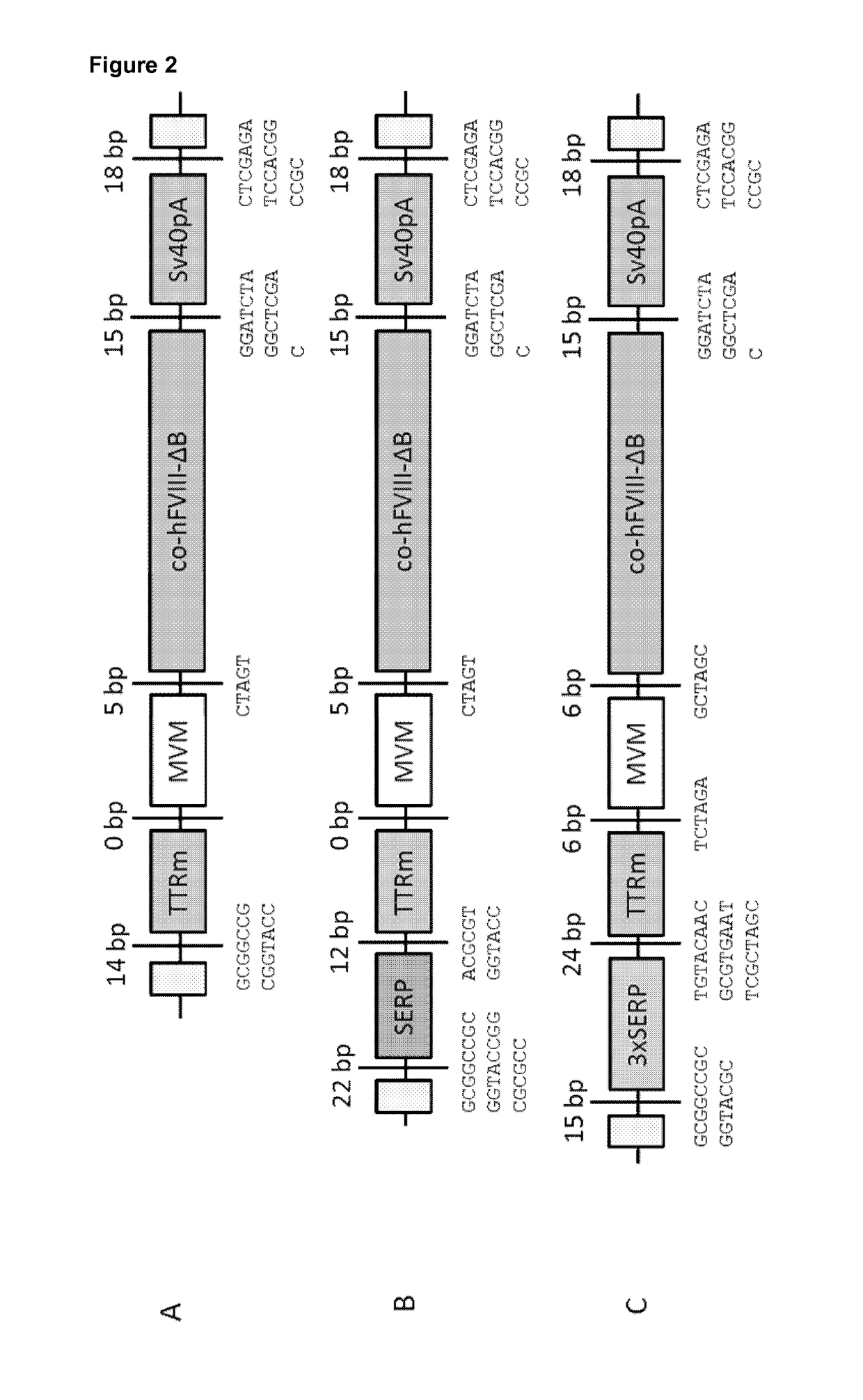Optimized Liver-Specific Expression Systems for FVIII and FIX
a technology of liver-specific expression and gene therapy, applied in the direction of drug compositions, peptide/protein ingredients, extracellular fluid disorder, etc., can solve the problems of increasing the risk of severe bleeding episodes and chronic joint damage, limited availability and high cost of purified clotting factors, and achieve the effect of enhancing liver-directed gene expression and increasing efficiency and safety of liver-directed gene therapy
- Summary
- Abstract
- Description
- Claims
- Application Information
AI Technical Summary
Benefits of technology
Problems solved by technology
Method used
Image
Examples
example 1
Design of the AAV Vectors Used
[0357]The design of the self-complementary (sc), double-stranded adeno-associated viral (AAV) vectors is depicted in FIG. 1. The minimal transthyretin promoter (TTRm) is driving the expression of the human codon-optimized factor IX (co-FIX-R338L) containing the hyper-activating, thrombophilic FIX mutation (R338L). The minimal TTR promoter (TTRm) is used in conjunction with either the Serpin enhancer (SERP), a triple repeat of the Serpin enhancer (3×SERP), the native TTR enhancer (TTRe), or a combination of a triple repeat of the Serpin enhancer and the native TTR enhancer (3×SERP-TTRe). The minute virus of mouse intron (MVM), the bovine growth hormone polyadenylation site (BGHpA) or a synthetic polyadenylation site (Synt.pA), and the inverted terminal repeats (ITR) are indicated; 3×SerpEnh means that this element was cloned as a triplet repeat upstream of the TTRm. The vector size (including both ITR's) is indicated.
[0358]FIG. 2 shows the design of the ...
example 2
Example 2 Studying the In Vivo Effect of 3×CRM8 and TTRenhancer on FVIII Expression in Various Constructs by Hydrodynamic Injection (2 ml) into CB17-SCID Mice
[0389]The aim of this example was to study the in vivo effect of 3×CRM8 and TTRenhancer on FVIII expression in various constructs by hydrodynamic injection (2 ml) into CB17-SCID mice.
[0390]Constructs:
[0391]The following vectors were compared for FVIII expression levels (cf. FIG. 22):
[0392]pAAVss-TTRm-MVM-coFVIIIdeltaB-Sv40pA (SEQ ID NO. 14);
[0393]pAAVss-3×SerpEnh-TTRm-MVM-coFVIIIdeltaB-Sv40pA (SEQ ID NO:16);
[0394]pAAVss-TTRe-TTRm-MVM-coFVIIIdeltaB-Sv40pA (SEQ ID NO:17); and
[0395]pAAVss-3×SerpEnh-TTRe-TTRm-MVM-coFVIIIdeltaB-Sv40pA (SEQ ID NO:22).
[0396]In a first experiment, the following conditions were used:
[0397]Mouse Model:
[0398]CB17-SCID, male, adult mice of 18-20 grams
[0399]Doses:
[0400]150 ng plasmid / mouse
[0401]Analysis Points:
[0402]Blood collection at Day1
[0403]No of Mice:
[0404]3 per condition
[0405]Design:
[0406]See the tab...
example 3
Studying the In Vivo Effect of 3×CRM8 and TTRenhancer in Combination with an AAT Promoter on FIX Expression in Various Constructs by Hydrodynamic Injection (2 ml) into C57BL / 6 Mice
[0422]In this experiment, the TTRm minimal promotor is replaced by another liver-specific promotor to show the versatility of the regulator element.
[0423]As a first example, the AAT liver-specific promoter (AAT) is tested.
[0424]Constructs:
[0425]Four different constructs were prepared as depicted in FIG. 23 (the sequences are depicted in FIG. 24):
[0426]pAAVss-3×SerpEnh-TTRe-AAT-MVM-co-FIX-R338L-BGHpA (SEQ ID NO:65);
[0427]pAAVss-3×SerpEnh-AAT-MVM-co-FIX-R338L-BGHpA (SEQ ID NO:66);
[0428]pAAVss-TTRe-AAT-MVM-co-FIX-R338L-BGHpA (SEQ ID NO:67); and
[0429]pAAVss-TTRe-3×SerpEnh-AAT-MVM-co-FIX-R338L-BGHpA (SEQ ID NO:68);
[0430]All constructs tested make use of the AAT promoter (SEQ ID NO.64).
[0431]Mouse Model:
[0432]C57BL / 6, male, adult mice of 18-20 grams
[0433]Doses:
[0434]1 μg and 2 μg plasmid / mouse
[0435]Analysis Poin...
PUM
| Property | Measurement | Unit |
|---|---|---|
| nucleic acid | aaaaa | aaaaa |
| nucleic acid expression | aaaaa | aaaaa |
| nucleic acid expression cassette | aaaaa | aaaaa |
Abstract
Description
Claims
Application Information
 Login to View More
Login to View More - R&D
- Intellectual Property
- Life Sciences
- Materials
- Tech Scout
- Unparalleled Data Quality
- Higher Quality Content
- 60% Fewer Hallucinations
Browse by: Latest US Patents, China's latest patents, Technical Efficacy Thesaurus, Application Domain, Technology Topic, Popular Technical Reports.
© 2025 PatSnap. All rights reserved.Legal|Privacy policy|Modern Slavery Act Transparency Statement|Sitemap|About US| Contact US: help@patsnap.com



